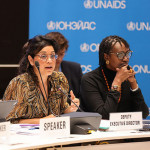The battle over scarce international funding for health programs has been raging for a number of years, and HIV is once again in the thick of the controversy. The most recent scuffle started in May 2008, when Roger England—the chairman of Health Systems Workshop, an organization promoting the use of health systems management and sciences in tackling medical problems in resource poor countries—published an article attacking the United Nations joint program on HIV/AIDS, known as UNAIDS.
In his British Medical Journal editorial, England criticized what he felt were efforts by UNAIDS and others to demand the world treat AIDS as an exceptional disease requiring heightened attention, care and resources over other diseases—what he called AIDS exceptionalism.
“The global HIV industry is too big and out of control,” England wrote. “We have created a monster with too many vested interests and reputations at stake, too many single issue [nongovernmental organizations]…too many relatively well paid HIV staff in affected countries and too many rock stars with AIDS support as a fashion accessory.”
England and others have complained about the unprecedented size and focused nature of not only UNAIDS but also the President’s Emergency Plan for AIDS Relief (PEPFAR), which began as a five-year $15 billion pledge by President George W. Bush in the 2003 State of the Union address to fund HIV prevention and provide antiretroviral (ARV) drugs in resource-poor nations. Adopted by Congress into law in May 2003, PEPFAR was extended and expanded to a $48 billion funding pledge through 2013.
Earmarking so much international funding to specifically fight HIV, the critics suggest, shortchanges efforts to fight other health problems.
A number of prominent AIDS organizations, including UNAIDS, swiftly responded to England’s objection. But criticism continues, notably in the form of arguments for and against continuing and expanding PEPFAR.
Some argue PEPFAR-style funding should drop its intense HIV focus and include more inclusive health programming for women and children—often the most vulnerable segments of a population—as well as the diarrheal and respiratory diseases that contribute to high mortality rates.
In a 74-page outline released December 1, 2009, the Obama administration signaled a shift in strategy, with recommendations for slowing the expansion of ARV drug distribution in favor of prevention and fighting other deadly diseases. Some AIDS activists were not pleased with this shift in focus, which seemed to them to be designed to placate calls to refocus PEPFAR away from HIV.
HIV costs much more to prevent and treat, the opponents of PEPFAR argue, compared with other deadly diseases. Therefore, they say, a larger share of the world’s health care funds ought to be spent on preventing and treating these other diseases, and less on HIV specifically. The underlying assumption is there will always be too few resources to meet global health care needs.
In response, two Harvard University professors—Rochelle Walensky, MD, MPH, and Daniel Kuritzkes, MD—are making the case in the January 15 issue of Clinical Infectious Diseases (available now online) that programs such as PEPFAR have not only succeeded in their mission, but have also had benefits that go far beyond their original intent.
PEPFAR, Walensky and Kurtizkes contend, has been an unqualified success in regards to its originally stated mission. By October 2008, they write, 10.1 million people worldwide were receiving HIV care, and 2.1 million were receiving HIV treatment. “AIDS-related mortality in PEPFAR countries decreased by 10.5 percent relative to non-PEPFAR countries,” they state, “a difference that translates into 1.2 million lives saved.”
The pair also laud the impact of HIV-specific care and treatment on many other aspects of health in PEPFAR-funded countries, writing, “Antiretroviral treatment and [PCP pneumonia medication] provided to HIV-infected adults in a Ugandan cohort was not only associated with a 95 percent decrease in mortality of infected adults, but also an 81 [percent] reduction in mortality of uninfected children and a 93 percent decrease in orphanhood.”
Moreover, Walensky and Kuritzkes point out that not treating people with HIV can have costs far beyond the illness or death of the individual. “Households with an HIV-infected family member consume the majority of their income on medical care and death costs, and follow a future cascade of lost wages…. Widespread household volatility portends country-wide economic instability,” Walensky and Kuritzkes write.
Some have argued that the kinds of programs funded by PEPFAR are not sustainable when the money runs out. The latest proposal to expand PEPFAR, explain Walensky and Kuritzkes, takes this into account.
Announcing these changes to PEPFAR on World AIDS Day, December 1, 2009, in Washington, DC, Eric Goosby, MD—the U.S. Global AIDS Coordinator—remarked, “It will not be an easy task to transition our emergency response, especially as we maintain high quality of services. But the move toward sustainability is an essential one. As we expand our HIV prevention, care and treatment efforts, we need to engage with our fellow international and multilateral partners to create a shared vision of a global response to this global responsibility.”
Current plans for PEPFAR place increasing emphasis on helping develop sustainable health care infrastructure in the participating countries, and on substantially increasing funds to treat related deadly diseases such as malaria and tuberculosis. Additional funds will also be targeted to needs of women and children.
“The perception that PEPFAR is at odds with dedicated efforts toward maternal and child health ignores the massive direct and indirect benefits PEPFAR has achieved already for mothers and children,” write Walensky and Kuritzkes. They conclude: “It may be that PEPFAR—by providing health infrastructure, HIV prevention, parental survival and the opportunity to sustain economic growth—is the most generous gift the United States can provide to future generations of those countries most in need.”
Global Funding for AIDS Is Justified
Two Harvard medical professors counter charges that HIV programs receive too large a slice of the global health funding pie.






3 Comments
3 Comments